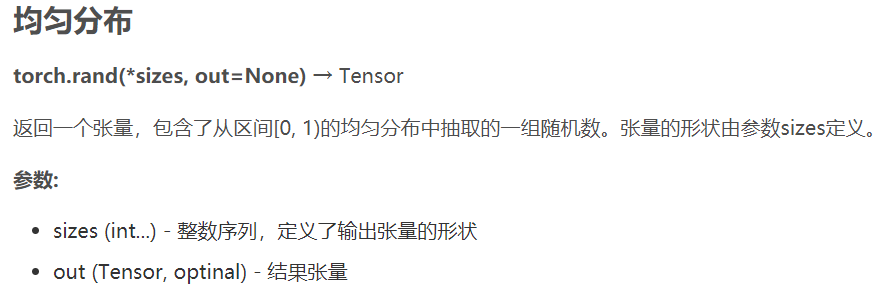1.torchvision.transforms是pytorch中的图像预处理包一般用Compose把多个步骤整合到一起,比如说
transforms.Compose([transforms.CenterCrop(10), transforms.ToTensor(),])
2.transforms中的函数
Resize:把给定的图片resize到given size; Normalize:Normalized an tensor image with mean and standard deviation; ToTensor:convert a PIL image to tensor (H*W*C) in range [0,255] to a torch.Tensor(C*H*W) in the range [0.0,1.0]; ToPILImage: convert a tensor to PIL imageScale:目前已经不用了,推荐用ResizeCenterCrop; ResizeCenterCrop:在图片的中间区域进行裁剪; RandomCrop:在一个随机的位置进行裁剪; RandomHorizontalFlip:以0.5的概率水平翻转给定的PIL图像; RandomVerticalFlip:以0.5的概率竖直翻转给定的PIL图像; RandomResizedCrop:将PIL图像裁剪成任意大小和纵横比; Grayscale:将图像转换为灰度图像; RandomGrayscale:将图像以一定的概率转换为灰度图像; FiceCrop:把图像裁剪为四个角和一个中心T; enCropPad:填充ColorJitter:随机改变图像的亮度对比度和饱和度
随机裁剪:transforms.RandomCrop class torchvision.transforms.RandomCrop(size, padding=None, pad_if_needed=False, fill=0, padding_mode=‘constant’) 功能:依据给定的size随机裁剪 参数: size- (sequence or int),若为sequence,则为(h,w),若为int,则(size,size) padding-(sequence or int, optional),此参数是设置填充多少个pixel。 当为int时,图像上下左右均填充int个,例如padding=4,则上下左右均填充4个pixel,若为32*32,则会变成40*40。 当为sequence时,若有2个数,则第一个数表示左右扩充多少,第二个数表示上下的。当有4个数时,则为左,上,右,下。 fill- (int or tuple) 填充的值是什么(仅当填充模式为constant时有用)。int时,各通道均填充该值,当长度为3的tuple时,表示RGB通道需要填充的值。 padding_mode- 填充模式,这里提供了4种填充模式,1.constant,常量。2.edge 按照图片边缘的像素值来填充。3.reflect,暂不了解。 4. symmetric,暂不了解。
class torchvision.transforms.RandomHorizontalFlip 随机水平翻转给定的PIL.Image,概率为0.5。即:一半的概率翻转,一半的概率不翻转。
class torchvision.transforms.ToTensor 把一个取值范围是[0,255]的PIL.Image或者shape为(H,W,C)的numpy.ndarray,转换成形状为[C,H,W],取值范围是[0,1.0]的torch.FloadTensor data = np.random.randint(0, 255, size=300) img = data.reshape(10,10,3) print(img.shape) img_tensor = transforms.ToTensor()(img) # 转换成tensor print(img_tensor) #没有/255
if the PIL Image belongs to one of the modes (L, LA, P, I, F, RGB, YCbCr, RGBA, CMYK, 1) or if the numpy.ndarray has dtype = np.uint8 In the other cases, tensors are returned without scaling.
class torchvision.transforms.Normalize(mean, std) 给定均值:(R,G,B) 方差:(R,G,B),将会把Tensor正则化。即:Normalized_image=(image-mean)/std。 mnist是灰度图,给出的应该是transforms.Normalize((0.1307 ), (0.3081 )) cifar10是transforms.Normalize((0.4914, 0.4822, 0.4465), (0.2023, 0.1994, 0.2010)) image net是([0.485, 0.456, 0.406], [0.229, 0.224, 0.225])
torchvision.datasets torchvision.datasets中包含了以下数据集 MNIST COCO(用于图像标注和目标检测)(Captioning and Detection) LSUN Classification ImageFolder Imagenet-12 CIFAR10 and CIFAR100 STL10 Datasets 拥有以下API: __getitem__ __len__ 由于以上Datasets都是 torch.utils.data.Dataset的子类,所以,他们也可以通过torch.utils.data.DataLoader使用多线程(python的多进程)。 举例说明: torch.utils.data.DataLoader(coco_cap, batch_size=args.batchSize, shuffle=True, num_workers=args.nThreads) torch.utils.data.DataLoader使用方法 数据加载器,结合了数据集和取样器,并且可以提供多个线程处理数据集。 在训练模型时使用到此函数,用来把训练数据分成多个小组,此函数每次抛出一组数据。直至把所有的数据都抛出。就是做一个数据的初始化
在构造函数中,不同的数据集直接的构造函数会有些许不同,但是他们共同拥有 keyword 参数。 In the constructor, each dataset has a slightly different API as needed, but they all take the keyword args:
- transform: 一个函数,原始图片作为输入,返回一个转换后的图片。(详情请看下面关于torchvision-tranform的部分) target_transform - 一个函数,输入为target,输出对其的转换。例子,输入的是图片标注的string,输出为word的索引。 MNIST dset.MNIST(root, train=True, transform=None, target_transform=None, download=False) 参数说明: - root : processed/training.pt 和 processed/test.pt 的主目录 - train : True = 训练集, False = 测试集 - download : True = 从互联网上下载数据集,并把数据集放在root目录下. 如果数据集之前下载过,将处理过的数据(minist.py中有相关函数)放在processed文件夹下。 COCO 需要安装COCO API 图像标注: dset.CocoCaptions(root="dir where images are", annFile="json annotation file", [transform, target_transform]) 例子: import torchvision.datasets as dset import torchvision.transforms as transforms cap = dset.CocoCaptions(root = 'dir where images are', annFile = 'json annotation file', transform=transforms.ToTensor()) print('Number of samples: ', len(cap)) img, target = cap[3] # load 4th sample print("Image Size: ", img.size()) print(target) 输出: Number of samples: 82783 Image Size: (3L, 427L, 640L) [u'A plane emitting smoke stream flying over a mountain.', u'A plane darts across a bright blue sky behind a mountain covered in snow', u'A plane leaves a contrail above the snowy mountain top.', u'A mountain that has a plane flying overheard in the distance.', u'A mountain view with a plume of smoke in the background'] 检测: dset.CocoDetection(root="dir where images are", annFile="json annotation file", [transform, target_transform]) LSUN dset.LSUN(db_path, classes='train', [transform, target_transform]) 参数说明: - db_path = 数据集文件的根目录 - classes = ‘train’ (所有类别, 训练集), ‘val’ (所有类别, 验证集), ‘test’ (所有类别, 测试集) [‘bedroom_train’, ‘church_train’, …] : a list of categories to load ImageFolder 一个通用的数据加载器,数据集中的数据以以下方式组织 root/dog/xxx.png root/dog/xxy.png root/dog/xxz.png root/cat/123.png root/cat/nsdf3.png root/cat/asd932_.png dset.ImageFolder(root="root folder path", [transform, target_transform]) 他有以下成员变量: self.classes - 用一个list保存 类名 self.class_to_idx - 类名对应的 索引 self.imgs - 保存(img-path, class) tuple的list Imagenet-12 This is simply implemented with an ImageFolder dataset. The data is preprocessed as described here Here is an example CIFAR dset.CIFAR10(root, train=True, transform=None, target_transform=None, download=False) dset.CIFAR100(root, train=True, transform=None, target_transform=None, download=False) 参数说明: - root : cifar-10-batches-py 的根目录 - train : True = 训练集, False = 测试集 - download : True = 从互联上下载数据,并将其放在root目录下。如果数据集已经下载,什么都不干。 STL10 dset.STL10(root, split='train', transform=None, target_transform=None, download=False) 参数说明: - root : stl10_binary的根目录 - split : 'train' = 训练集, 'test' = 测试集, 'unlabeled' = 无标签数据集, 'train+unlabeled' = 训练 + 无标签数据集 (没有标签的标记为-1) - download : True = 从互联上下载数据,并将其放在root目录下。如果数据集已经下载,什么都不干。
detach()
当我们再训练网络的时候可能希望保持一部分的网络参数不变,只对其中一部分的参数进行调整;或者只训练部分分支网络,并不让其梯度对主网络的梯度造成影响,
这时候我们就需要使用detach()函数来切断一些分支的反向传播
detach()[source]
返回一个新的Variable,从当前计算图中分离下来的,但是仍指向原变量的存放位置,不同之处只是requires_grad为false,得到的这个Variable永远不需要计算其梯度,不具有grad。
即使之后重新将它的requires_grad置为true,它也不会具有梯度grad
这样我们就会继续使用这个新的Variable进行计算,后面当我们进行反向传播时,到该调用detach()的Variable就会停止,不能再继续向前进行传播
import torch
a = torch.tensor([1,2,3.],requires_grad=True)#3后面一定有个.
print(a.grad)
out = a.sigmoid()
out.sum().backward()
print(a.grad)
None
tensor([0.1966, 0.1050, 0.0452])
import torch
a = torch.tensor([1,2,3.],requires_grad=True)#3后面一定有个.
print(a.grad)
out = a.sigmoid()
print(out)
#添加detach(),c的require_grad=False
c = out.detach()
print(c)#没有梯度
#没有对c更改,并不影响backward()
out.sum().backward()
print(a.grad)
#使用新生成的Variable进行反向传播
c.sum().backward()
print(a.grad)
None
tensor([0.7311, 0.8808, 0.9526], grad_fn=<SigmoidBackward>)
tensor([0.7311, 0.8808, 0.9526])
tensor([0.1966, 0.1050, 0.0452])
RuntimeError: element 0 of tensors does not require grad and does not have a grad_fn
import torch
a = torch.tensor([1,2,3.],requires_grad=True)#3后面一定有个.
print(a.grad)
out = a.sigmoid()
print(out)
#添加detach(),c的require_grad=False
c = out.detach()
print(c)#没有梯度
c.zero_()
print(c)
print(out)#修改c的同时影响out的值
#没有对c更改,并不影响backward()
out.sum().backward()
print(a.grad)
None
tensor([0.7311, 0.8808, 0.9526], grad_fn=<SigmoidBackward>)
tensor([0.7311, 0.8808, 0.9526])
tensor([0., 0., 0.])
tensor([0., 0., 0.], grad_fn=<SigmoidBackward>)但是还有梯度
RuntimeError: one of the variables needed for gradient computation has been modified by an inplace operation: [torch.FloatTensor [3]], which is output 0 of SigmoidBackward, is at version 1; expected version 0 instead. Hint: enable anomaly detection to find the operation that failed to compute its gradient, with torch.autograd.set_detect_anomaly(True).
torch.randn和torch.rand有什么区别

>>> torch.rand(2,3)
tensor([[0.1619, 0.0097, 0.2034],
[0.6225, 0.1300, 0.3960]])

